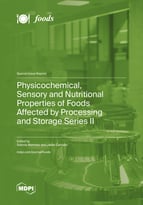Physicochemical, Sensory and Nutritional Properties of Foods Affected by Processing and Storage Series II
A special issue of Foods (ISSN 2304-8158). This special issue belongs to the section "Food Quality and Safety".
Deadline for manuscript submissions: closed (20 May 2023) | Viewed by 29796
Special Issue Editors
Interests: food processing; food quality; food storage; nutritional properties; sensory attributes
Special Issues, Collections and Topics in MDPI journals
Interests: food quality; functional foods; fermented foods; meat products; meat product innovation; dairy products; cheese ripening
Special Issues, Collections and Topics in MDPI journals
Special Issue Information
Dear Colleagues,
Processing and storage for increasing the safety and shelf life of foods involve different practices and actions which affect the physicochemical, nutritional, and sensory properties of the final products. Processing can produce effects that change or convert foods into safer, more edible, enjoyable, and/or palatable products and can increase the digestibility and/or bioavailability of some nutrients and bioactive compounds and, in some cases, their concentrations. However, processing and storage can also have negative effects, such as the loss of nutrients and the formation of toxic compounds and/or substances with negative effects on sensory properties. Therefore, the processing and storage of foods need to be optimized in order to promote positive effects and to prevent undesired consequences.
Supported by these facts, the industry needs to innovate and develop products through a better understanding of the changes that take place during different types of processing and storage and their relation to sensory attributes.
For all these reasons, further studies and research are essential instruments to improve and continue to profit from the different systems of food processing and storage. This Special Issue aims to gather the latest advances and to be a useful tool for researchers and professionals in this scientific area.
Prof. Dr. Javier Carballo
Prof. Dr. Sidonia Martinez
Guest Editors
Manuscript Submission Information
Manuscripts should be submitted online at www.mdpi.com by registering and logging in to this website. Once you are registered, click here to go to the submission form. Manuscripts can be submitted until the deadline. All submissions that pass pre-check are peer-reviewed. Accepted papers will be published continuously in the journal (as soon as accepted) and will be listed together on the special issue website. Research articles, review articles as well as short communications are invited. For planned papers, a title and short abstract (about 100 words) can be sent to the Editorial Office for announcement on this website.
Submitted manuscripts should not have been published previously, nor be under consideration for publication elsewhere (except conference proceedings papers). All manuscripts are thoroughly refereed through a single-blind peer-review process. A guide for authors and other relevant information for submission of manuscripts is available on the Instructions for Authors page. Foods is an international peer-reviewed open access semimonthly journal published by MDPI.
Please visit the Instructions for Authors page before submitting a manuscript. The Article Processing Charge (APC) for publication in this open access journal is 2900 CHF (Swiss Francs). Submitted papers should be well formatted and use good English. Authors may use MDPI's English editing service prior to publication or during author revisions.
Keywords
- food processing
- food quality
- food storage
- nutritional properties
- sensory attributes








